Top 5 Explosive Exercises For Athletes
I love to warm up my feet and knees because I’m old. Walking on a PVC pipe does a great job for the feet. For the knees, I do a hybrid Kang-Spanish squat. Standing on a slant board and having a band anchored and behind the knees, I keep my chest forward and load the heck out of my hamstrings. From there, I squat down and push back with the hamstrings. These first two exercises are great so that when we head into the explosive series of exercises everything feels strong, mobile, and ready to go.

The next thing we do is toe hops which involve keeping the legs stiff and just jumping rapidly from the feet and calves. The final warm-up exercise is an explosive drop lunge that involves jumping off one foot and landing on the other foot. Focus on holding the landing by loading the quads and hamstrings.
That then leads to the best explosive exercises for athletes!
1. Two Box Power Snatch
No access to boxes? Don’t worry about it. Do a high hang power snatch. Don’t know how to snatch? Stop not snatching and learn how to do it! Snatching teaches the body how to accelerate a bar very rapidly, creates co-contractions in the shoulders when catching, co-contractions in the trunk, and the movement is as explosive as can be.
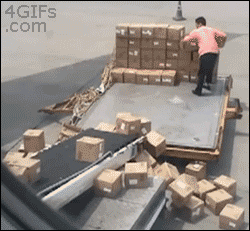
We want to start with performing four doubles of the two box power snatch to help stimulate the nervous system for the rest of the training session. Now with the technique of the power snatch from two boxes, we want to think knees under as the bar comes over the knees to get into a vertical jump/athletic position. Push the knees under right away from the two block power snatch.
If the high hang version has to be done, it will load the hamstrings a little bit more because of the eccentric portion of the lift.
The power snatch from two blocks is easy to learn, is easy on the back, and will help develop explosive athleticism.
2. Quarter Squat And Jump With A Barbell
As an athlete throwing shot put at Penn State, I loved this movement. I would put on 70 to 90 kilos on the bar when peaking. This is a movement Warner Gunther made popular in the 80s’. I think it is a great exercise to develop explosiveness.
I also recommend starting with an empty bar.
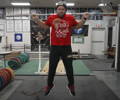
Perform the movement nice and explosively. Now as the body adapts and you get used to the movement, weight can be put on the bar. I don’t recommend going above 60 kilos.
Hesitant to do the jumps with a barbell? No problem! The movement can be done with a PowerLastic band. Step into the handles and put the PowerLastic band around the neck. The bonus of the band is that on the grounding, the energy of gravity and the band will pull the body down requiring tension on the counter-movement. The PowerLastic is definitely safer than the bar on the lower back.
Four sets of four or five sets of three is a great range of reps and sets to use.
3. Skater Squat Into Banded Hip Lock
Using a PowerLastic band anchored to a solid holding, place the handles in the hand. Without letting the back foot touch, skater squat backward and let the knee come into contact with a pad or the ground. Upon contact, immediately explode up through the grounded leg, extend the bands, and hold a hip lock.
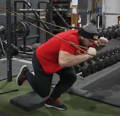

Think about the knee tracking forward in the squatting leg. It will help a ton with acceleration and explosiveness from a starting position because the body is in a full range of motion from a unilateral aspect. Use the movement by doing multiple sets of three or four reps on each side. This is a very difficult movement.
I like to super-set this movement with some contrast methods. I’ll anchor the PowerLastic and loop it around my body. Facing laterally, I will jump unilaterally and rotate 90 degrees, pausing in the landing. As the body wakes up, I’ll do the jumps in rapid succession when landing on the single leg as the band pulls the boyd back towards the anchor point. Not only is the body training unilaterally, but it is also be trained on multiple different planes while rotating. This teaches the body not only explosiveness but preps the body’s kinesthetic vocabulary for chaos coordination.


4. Plate Snatch To A Box
I stole this from Frans Bosch. Reflexive training is going to be the next big thing in five years. Everyone is going to be doing this. Reflexive work is the wave that we will see sports performance and physical therapy going in. Reflexive work trains bodily skills so that we can be more stable and ultimately healthier. End rant.
To do the plate snatch to a box, we want to rotate slightly with the non-grounded foot behind the grounded foot as pictured below.
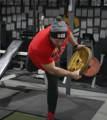
The body will then come forward with nice extension off the toe off position. The movement is almost like an RDL into a snatch into a forward lunge into stepping on to a box. The body will feel the hip and hamstring loading as it then contributes into the drive forward into the step onto the box.
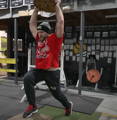
5. Bounds
Whenever we do contrast training, I like to rest two minutes. After performing the plate snatch to a box, we can do one of two things. We can do double leg bounds which are easy. What I prefer to have athletes do is single-leg bounds on each side. Do three jumps on one leg in succession before doing the same movement on the other leg.

Try to drive and get the height. I like to see a higher heel recovery while doing the bounds because it forces athletes to be more reactive through the hip and planting. Sometimes I see athletes with a lower heel recovery not putting the force into the ground. If we put a lot of force into the ground we will get that back into the body creating a better ground reaction force

Recap
Putting a lot of force into the ground will allow us to get that force delivered back into the body creating a better ground reaction force. Think of Newton’s Law, “For every action, there is an equal and opposite reaction.” To be faster we need to teach the body how to be more explosive. The five exercises above do just that! The exercises teach the body how to be more explosive and, in turn, lead to be faster.
Need More Explosive Training …
DANE MILLER
Dane Miller is the owner and founder of Garage Strength Sports Performance. He works with a select handful of clients on building comprehensive programs for fitness and nutrition. Several times a year he leads a workshop for coaches, trainers, and fitness enthusiasts.


